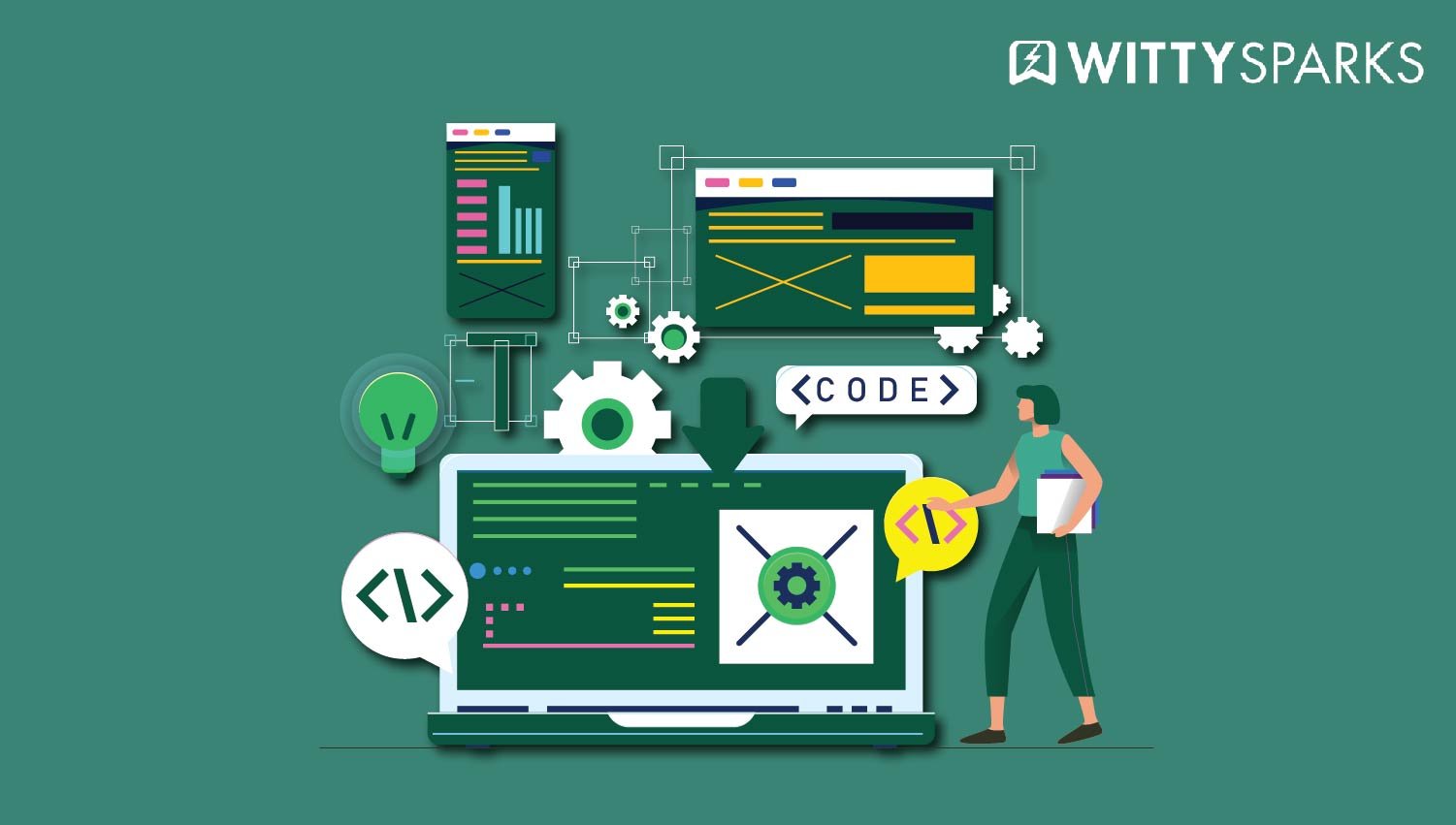Applications are the mainstay of the digital world. Businesses and individuals use thousands of apps to streamline their operations and entertainment and manage their routine tasks.
But building such apps takes time, effort, and, most importantly, a lot of coding, right?
On this page
Traditionally, these would be considered code apps, requiring programming knowledge, but now no-code solutions allow users to build apps without writing any code.
WRONG! Technology has evolved a lot in the past decade. The need for hypercoding to build applications, whether Progressive Web Apps or Native Apps, is gone.
Today is the age of automation and AI. Most no code apps are designed for ease of use and rapid deployment, making app creation accessible to a wide audience.
The same has happened with app builders. There are hundreds of no-code app builders that let you create your dream apps, with few clicks, drag-and-drop, and no coding at all! Each of these platforms serves as a no code tool, empowering users to build apps without any technical skills.
I’ve had an opportunity to deal with a lot of such no code app builders in the past. But which one is the best no code app builder out of all? Well, it depends a lot on the users’ needs, the type of app they want, and their budget.
So, I decided to create a list of the top no-code app builders that can help developers and designers in their app-building endeavors. So, without wasting much time, let’s jump onto the list right away!
Introduction to App Building
App building has never been more accessible, thanks to the evolution of no code app builders. Whether you’re dreaming up the next big app idea or looking to streamline your business with internal tools, today’s no code platforms make it possible for anyone to jump into app building, no technical background required.
With a no code app builder, you can design, develop, and launch web apps, mobile apps, and even complex apps for your business or personal use, all without writing code.
The beauty of these app builders lies in their intuitive drag and drop tools and visual programming languages, which let you bring your app ideas to life quickly and efficiently.
From simple apps to robust internal tools, no code app builders empower users to create apps that fit their unique needs. Whether you’re a solo entrepreneur, a small business owner, or part of a larger team, these platforms open up a world of possibilities for app building, no code required!
What are No-Code App Builders?
No-code app builders are powerful platforms designed to help users create apps without the need for writing code. Instead of relying on traditional development, these tools offer a visual interface where you can design and develop web apps, native mobile apps, and progressive web apps with ease.
By using drag and drop tools and pre-built components, anyone can turn their app ideas into reality, no programming experience necessary.
These platforms often integrate seamlessly with existing data sources like Google Sheets, making it simple to build apps that leverage your current business data.
Whether you want to create apps for your team, launch a new product, or experiment with innovative app ideas, no code app builders provide the flexibility and functionality you need.
Even professional developers use these tools to quickly prototype and test new concepts, saving time and resources. With no code app builders, the power to create apps is truly in your hands.
Key Features of App Builders
The best no code app builders come packed with features that make creating apps a breeze. At the heart of these platforms are drag and drop tools and visual programming languages, allowing you to build complex apps without any coding.
Many no code app builders also offer an extensive plugin marketplace, so you can easily add new features and integrations as your app grows.
Key features often include user authentication, advanced logic, and API access, giving you the power to create apps that are both secure and highly functional.
Integration with existing data sources like Google Sheets is a common benefit, making it easy to manage and update your app data. Pre built components and templates help you get started quickly, while customization options ensure your app stands out.
Many of the best no code app builders also provide a free tier, so you can experiment and build your first app without any upfront investment.
Plus, direct publishing to app stores means you can share your creations with the world in just a few clicks. With these features, building and launching apps has never been easier.
App Development Process
The app development process has been transformed by no code app builders, making it faster and more accessible than ever. It all starts with designing your app using a visual editor or drag-and-drop interface, where you can lay out your screens and user interface without any technical hurdles.
Next, you develop your app by adding features and functionality, using pre built components and plugins to bring your vision to life.
Once your app is ready, deployment is just as straightforward. With a no code app builder, you can publish your app directly to app stores like the Apple App Store or Google Play Store, or use it as an internal tool within your organization.
This streamlined approach to app development means you can create apps, iterate quickly, and reach your audience without the traditional barriers of coding and complex development cycles.
Whether you’re building your first app or expanding your digital offerings, no code app builders make the entire process smooth and efficient.
Choosing the Best No-Code App Builder
Selecting the best no code app builder for your project comes down to understanding your specific needs and goals. Are you looking to build web apps, native mobile apps, or both?
Do you need advanced features like user authentication and API access, or are you seeking a simple, drag-and-drop interface for a straightforward app? The right no code app builder will align with your technical expertise, desired level of customization, and the type of app you want to create.
Consider the purpose of your app, your target audience, and the features you need to deliver a fully functional app. Some platforms excel at building mobile apps, while others are tailored for web apps or internal business tools.
If you require advanced features, look for a code app builder that offers robust options and flexibility. On the other hand, if you want to get started quickly, a platform with pre built components and an intuitive interface might be the best fit.
By evaluating these factors, you can choose the best no code app builder for your project and bring your app ideas to life, no writing code required. With the right platform, you’ll be able to create professional, high-quality apps that meet your needs and exceed your expectations.
1. Bubble
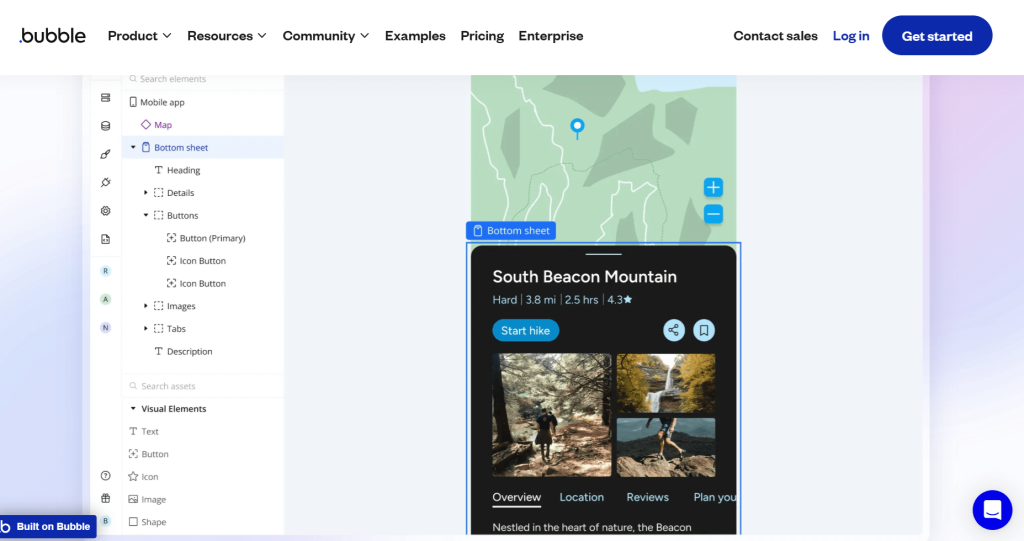
Bubble is one of the oldest no-code app builders you’ll find on the market today. The tool is exceptionally well-designed and easy to use. You can create eye-pleasing and fully functional apps using this tool.
It was founded by Emmanuel Straschnob and Josh Haas. Today, it has evolved into an app-building giant. A lot of startups, entrepreneurs, and even big businesses today use Bubble to create apps with a few simple clicks.
This no code app builder comes with a fully functional visual editor along with drag and drop builder. Bubble features its own visual programming language, which makes the building process intuitive and accessible for users of all skill levels.
Result? You can build your app using readymade elements without the need for coding. Your turnaround time cuts short, and you can get your app up and running in no time.
The Bubble has very powerful backend capabilities. So you can manage your database and set workflows pretty easily. You can define and expand your app’s data model within Bubble to ensure your application scales effectively.
On top of that, it’s third-party integration-friendly. So you can add a plethora of API integrations to your app using this no-code app builder, and quickly enhance app capabilities by dropping plugins from Bubble’s plugin marketplace.
This no code app builder has a massive ecosystem for its users. This includes Bubble’s plugin marketplace that offers hundreds of plugins with pre made functionality, a very active community forum, and infinite resources for new users.
In short, you can turn your outstanding ideas into tangible and high-performance web applications without the need of coding using this no code app builder. The variety of custom applications and apps built with Bubble demonstrates its flexibility and ability to support a wide range of use cases.
Features I loved in Bubble
- Drag-and-drop visual editor.
- Customizable workflows.
- Hyper-responsive design capabilities.
- Massive plugin marketplace.
- API integrations.
- User authentication.
- Database management.
- Version control.
- Collaboration tools.
- Extensive documentation and community support.
Pricing
Bubble offers diversified pricing options to cater to a massive:
- Free: $0/month. This option is excellent for those who just want to give this no code app builder a testing shot. You get 50,000 workload units per month and 500MB of storage with this one.
- Starter: $29/month. This plan is perfect for those who want to use Bubble to launch their applications. It comes with 175,000 workload units per month. On top of that, you get custom domain support and basic version control.
- Growth: $119/month. Designed for growing applications, offers 250,000 workload units per month, enhanced security features, and premium support.
- Team: $349/month. It’s tailored for teams and includes 500,000 workload units per month, advanced collaboration tools, and sub-app capabilities.
- Enterprise: Custom pricing. It’s best suited for large organizations with specific requirements.
These plans are structured to support users from the initial development stages to scaling complex applications.
2. FlutterFlow
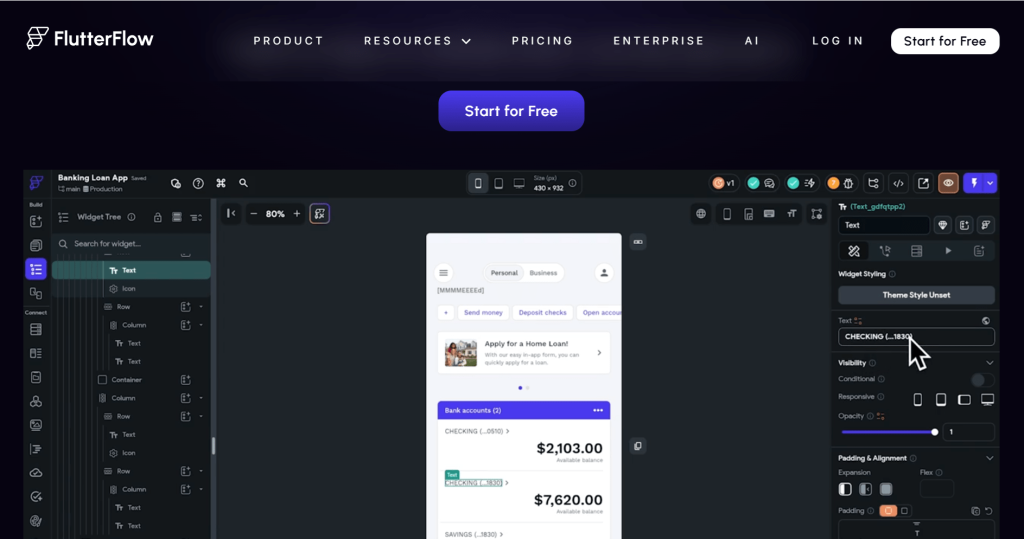
Want to create native apps for mobile, web, and desktops using a single code base? With FlutterFlow, you can easily build a native mobile app that can be published directly to iOS and Android app stores, ensuring platform-specific performance and features.
While it was traditionally a cross-platform app builder, today, it comes with no-code app-building capabilities.
This no code app builder was the result of a wonderful idea; its creators wanted to bridge the gap between design and development. The result was FlutterFlow.
Users can craft agile and high-performance applications using this no code app builder. It comes with tons of readymade templates, widgets, and other elements to create intuitive applications.
What I love about FlutterFlow is its ability to integrate with Firebase. The integration is buttery-smooth, and it helps you with real-time data handling and authentication features. So, if you are looking to accelerate your app development process, this no code app builder can get the job done.
The building process in FlutterFlow is highly visual and step-by-step, allowing users to design and develop their apps in a modular and intuitive way.
This no code app builder supports widgets and even custom codes if you want to add more functionality to your app. The tool is all about hyper-responsive design that runs smoothly across multiple platforms.
Features I loved FlutterFlow
- Intuitive drag-and-drop interface.
- Real-time previews.
- Firebase and Supabase integration.
- Custom code support.
- Responsive design tools.
- Pre-built templates and components.
- Basic features including database structuring, user interface (UI) creation, and logic building, enabling both non-technical users and professional developers to efficiently create apps.
- API integration.
- One-click deployment to app stores.
- Collaboration features.
- Extensive documentation and tutorials.
Pricing
FlutterFlow provides several pricing tiers to cater to different user requirements:
- Free: $0/month. Allows users to build and test applications with access to core features.
- Standard: $30/month. Includes code and APK downloads, custom domain publishing, and testing on local devices.
- Pro: $70/month. Offers advanced features such as GitHub integration, branching, one-click localization, and direct deployment to app stores.
- Teams: $70/user/month. Designed for collaborative development, providing real-time collaboration, project-level access controls, and centralized billing.
3. AppSheet
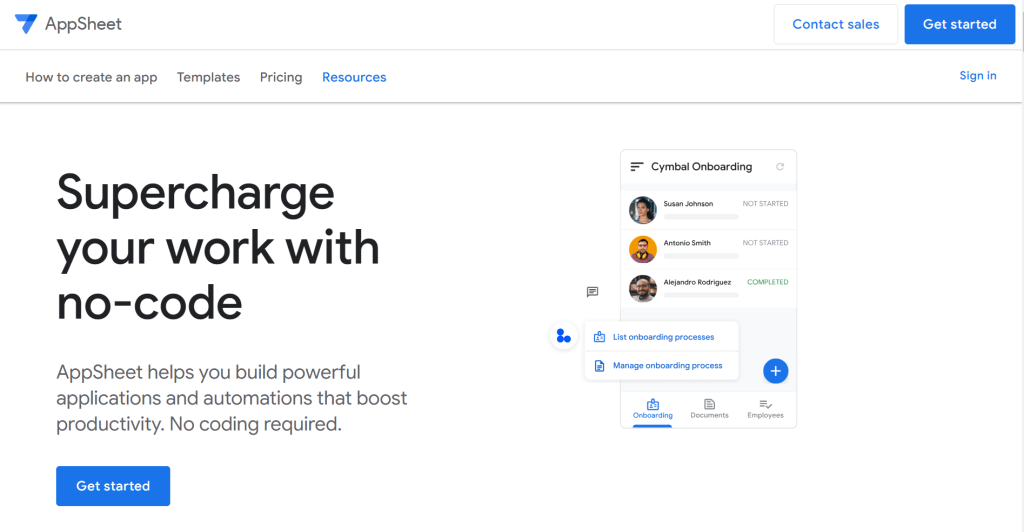
What if I tell you there is a no code app builder that you can use to create apps directly from data sources? Yup, that’s what AppSheet is all about! You can use this no code app builder to create apps from data sources like Excel, Google Sheets, and SQL databases!
The best part? You don’t have to write any code for this. This tool has gained immense popularity as users can create apps for specific operational needs within a short span.
AppSheet also excels at automating workflows, allowing users to streamline business processes and improve efficiency. They don’t have to spend a lot of time on coding, and hence, they can reduce their turnaround time.
As this no code app builder integrates with other platforms seamlessly, data management becomes very convenient.
The user-friendly interface, simple drag-and-drop features, and exceptional flexibility help users manage data effectively, making this no code app builder one of the most powerful no-code app builders in the market right now.
Features AppSheet
- Drag-and-drop app builder
- Integration with multiple data sources
- Automated workflows
- Offline access
- Data security and user management
- Customizable UX
- Real-time data updates
- Machine learning capabilities
- Barcode scanning
- GPS and maps integration
- Client portals for secure client access and data management
Pricing
AppSheet offers several pricing plans to accommodate different user needs:
- Starter: $5 per user per month. Includes basic app and automation features, integration with standard authentication providers, and community support.
- Core: $10 per user per month. Offers advanced app and automation features, application security controls, and email support.
- Enterprise Standard: Pricing varies based on application features. Provides advanced data and user management, team collaboration options, and enhanced security features.
- Enterprise Plus: $20 per user per month. Pricing varies based on application features. It includes all features of the Enterprise Standard plan, plus enterprise data services and governance options.
4. Airtable
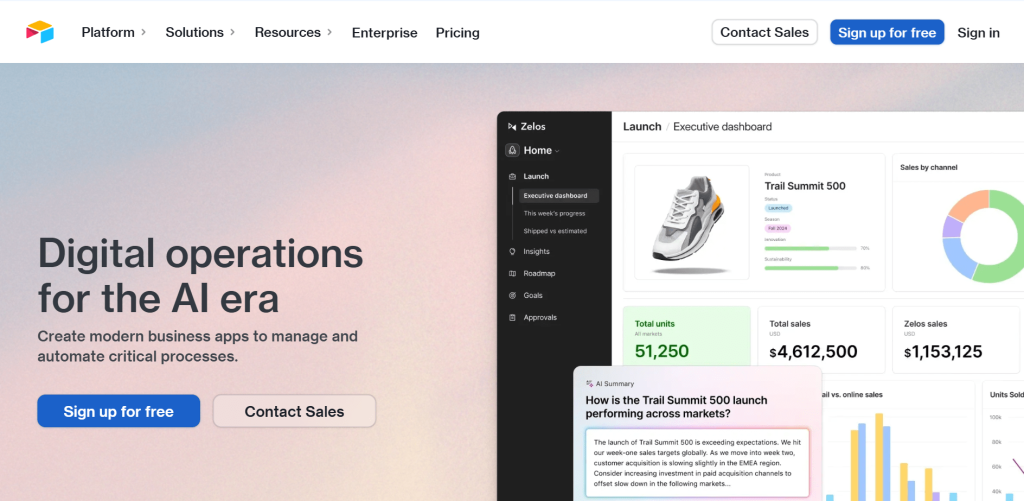
Airtable is a cloud-based no-code platform that merges the simplicity of a spreadsheet and relational database. As a result, businesses can organize and automate their data into highly intuitive dashboards and interfaces.
Using this no code app builder, you can create interlinked databases and define your app’s data model to ensure data integrity and scalability. This is a perfect solution for teams that are managing projects, customer relationships, inventory, and workflows.
One of Airtable’s strongest features is its automation and integration capabilities. You can easily connect your databases to third-party apps like Slack, QuickBooks, Zapier, and more. This helps streamline your entire data across multiple platforms.
You also get the benefit of no-code automation with this no code app builder. This makes it easy to update records, send notifications, and sync data between tables.
Airtable is widely used for both internal business tools and external applications. You can integrate your Airtable backend to other no-code app builders like Adalo, Bubble, and Glide to create high-utility apps.
Airtable supports no code app development by providing a flexible backend that can be customized and scaled as your application grows.
Features I Loved in Airtable
- Relational database support that allows you to link records between tables for structured data management
- Unlimited bases so you can create multiple databases for different business needs
- Automation helps you set up workflows to trigger actions without manual intervention
- Third-party integrations allow you to connect with apps like Slack, Zapier, QuickBooks, and Google Sheets
- Custom branding so you can add company logos for a professional backend appearance
- The multi-view display gives you the option to use the grid, kanban, gallery, and calendar views for data visualization
- Collaboration tools to manage permissions and access levels for different team members
- App-builder compatibility to connect Airtable with Adalo, Bubble, and Glide to create full applications
- Ideal for internal business apps such as onboarding tools, workflow automation, and employee engagement solutions, enabling quick and easy development without traditional coding
Pricing
- Free: Includes unlimited bases, 1,200 records per base, and 2GB of attachments.
- Team: $20/month per user. It supports 50,000 records per base, 25,000 monthly automation, and advanced permissions.
- Business: $45/month per user. It offers 125,000 records per base, 100,000 automation, and enterprise-grade admin controls.
- Enterprise Scale: Custom pricing. Comes with unlimited databases, advanced security, and priority support.
5. Glide
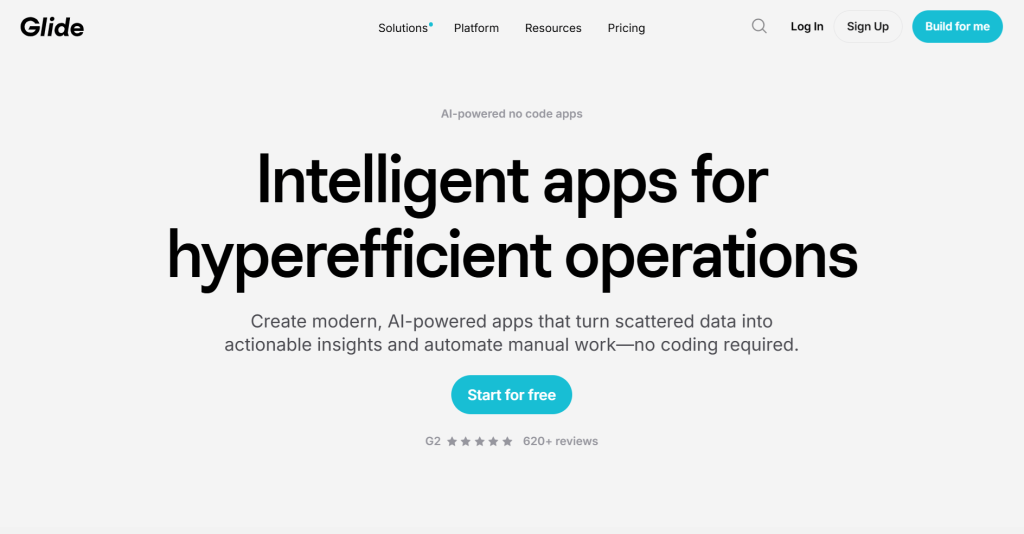
Glide is another powerful no code app builder that’s specially designed for medium to large-sized businesses. It allows you to create lean, fully functional web apps and Progressive Web Apps.
A progressive web app is a type of application that can be installed directly on devices, works via the internet, and offers a native app-like experience without needing app store approval, Glide makes it easy to build and distribute these apps. Glide is focused totally on data-driven applications.
This is entirely different from the traditional mobile app builders. That’s why this no code app builder is becoming quite popular among organizations that want to build project management dashboards, inventory trackers, and CRM systems.
Glide’s interface is one of the most polished among no code app builders. So users get to build the desired app with minimal effort.
This no code app builder provides over 100 pre-built templates, covering categories like AI-powered tools, HR management, sales tracking, and more.
You can also use Glide to create landing pages for marketing campaigns or lead capture. Users can integrate databases from Google Sheets, Airtable, and SQL while leveraging Glide AI to enhance automation and data processing.
Glide also supports integration with other apps, allowing you to connect with various tools to enhance your app’s functionality and automate workflows.
But Glide, too, comes with certain limitations. The biggest one is that you cannot publish your apps directly on the Apple App Store or Google Play Store. On top of that, no code app builder’s pricing is a bit higher.
So, it might not be suitable for individual entrepreneurs or small-scale freelancers who lack a pre-existing database.
Features I Loved in Glide
- Extensive template library – Over 100 categorized templates for fast app creation
- Range of apps built – Create everything from project management dashboards to CRM systems using no-code tools
- Data-first approach – Seamless integration with Google Sheets, Airtable, and SQL
- Glide AI tools – Automates tasks, processes images and optimizes data organization
- Powerful customization – Drag-and-drop layout editor with real-time previews
- Third-party integrations – Connect with business tools like Zapier, QuickBooks, and Slack
- Multi-user access – Allows role-based authentication and permission control
- PWA support – Apps function like native apps without requiring store publishing
- Scalability – Ideal for enterprise use with high-volume data management capabilities
Pricing
- Free: $0/month, allows one app, 10 personal users, no updates, and up to 25,000 rows.
- Maker: $49/month (billed yearly), supports 3 apps, unlimited personal users, 500 updates (+$0.02 per extra update), and up to 50,000 rows.
- Business: $199/month (billed yearly), includes unlimited apps, 30 users (+$5 per extra user), 5,000 updates (+$0.02 per extra update), and up to 100,000 rows.
- Enterprise: Custom pricing provides unlimited apps, custom users, custom updates, and up to 10 million rows. Also includes Glide Bulk API and Single Sign-On (SSO).
6. Softr
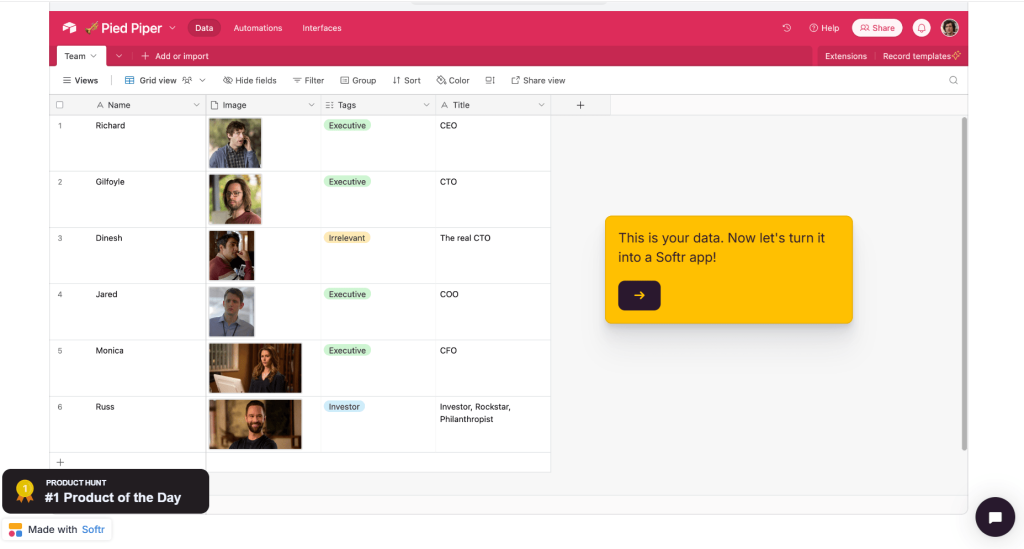
Need a no code app builder that can help you build powerful Progressive Web Apps and web apps for internal business applications? Softr has got you covered!
You can use this no code app builder to build highly sophisticated and functional apps using your existing databases, including client portals for secure client access and data management.
You can integrate a lot of powerful database services like Airtable, PostgreSQL, Supabase, and Xano. So, if you are already using any of this managed structured data, this no code app builder makes absolute sense.
With Softr, you get a block-based system for building applications. This visual editor removes the need for coding entirely and cuts short your turnaround time. The best part? It’s AI-powered! So you can create desired templates for your applications based on your input.
Imagine the time you would save with this feature! The only problem? This no code app builder is focused on internal tools like CRM systems and project management applications, excelling at automating workflows to streamline business processes and improve efficiency.
So, you cannot create native mobile apps for the Apple App Store or Google Play Store.
But wait, there is one feature that very few code builders offer. It’s the built-in SEO-optimization feature of Softr. You can use this feature to rank your app way higher on search engines.
It obviously offers the facility to integrate third-party services like Stripe for payments, Zapier for automation, and Mailchimp for email marketing.
Features I Loved in Softr
- Pre-built templates for quick development of business apps.
- AI-powered app generator to create apps in minutes.
- Database integrations with Airtable, PostgreSQL, and more.
- The drag-and-drop block system for fast, intuitive app building.
- Basic features including database structuring, user interface creation, and workflow logic, enabling both non-technical users and developers to efficiently build apps.
- SEO tools to improve the discoverability of web apps.
- Third-party integrations with Stripe, Zapier, Mailchimp, and more.
- User authentication & access control for secure app usage.
- No-code automation with workflow triggers and notifications.
- Custom code support (JavaScript & CSS) for added flexibility.
Pricing
- Free: $0/month, includes 1 published app, 100 external users, 5 internal users, and limited features.
- Basic: $49/month, supports custom domains, 10 internal users, and 1,000 external users.
- Professional: $139/month, includes advanced features like charts, kanban boards, and API access.
- Business: $269/month, offers mobile-friendly PWAs, 10,000 external users, and premium integrations.
- Enterprise: Custom pricing for organizations needing advanced security, SSO, and dedicated support.
7. Quickbase
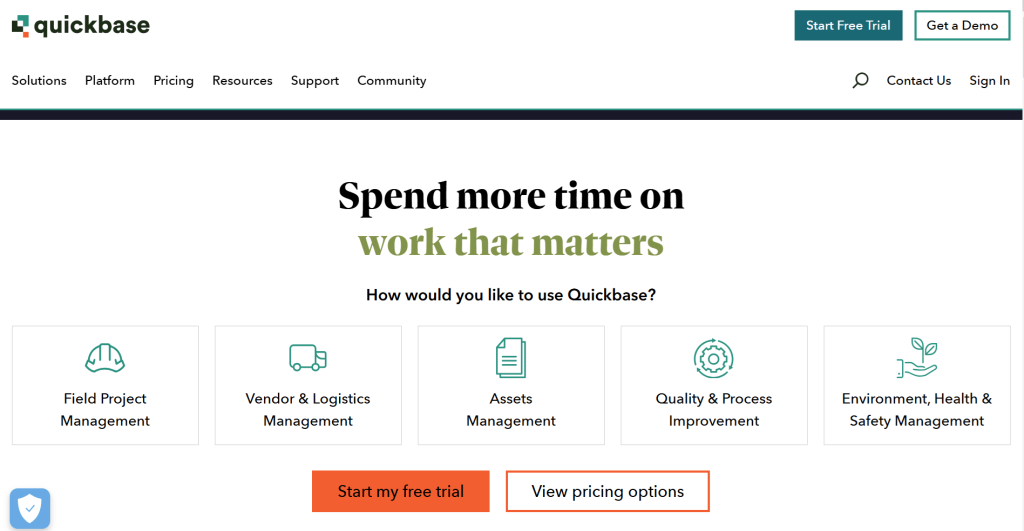
Quickbase is a cloud-based no-code app builder that helps businesses build fully tailored applications. Users can automate the entire workflow without the need for coding knowledge.
This no code app builder offers a highly intuitive visual development interface. This allows users to create databases, craft highly engaging applications, and define all the business rules. The best part? You can do it with simple drag-and-drop tools.
You can use this no code app builder for asset tracking, project management, and custom relationship management. You can collaborate in real-time, and hence, multiple users can access and update information on the application using this no-code app builder. This helps maintain data integrity.
Quickbase comes with super powerful automation features. It excels at automating workflows, allowing you to eliminate repetitive tasks and streamline business processes with accurate rule-based workflows.
We all know how important third-party integrations are, right? And Quickbase takes care of this too. You can easily integrate Salesforce, Outlook, and Slack. This ensures seamless data synchronization.
It doesn’t matter if you are a startup or an enterprise; this no code app builder has got you covered. It offers role-based permissions and fully customizable dashboards to match all your mission-critical needs. You can use these scalable and flexible features to boost your productivity multifold.
Features in Quickbase
- Drag-and-drop application builder for intuitive design.
- Pre-built templates to accelerate application development.
- Real-time data collection and reporting capabilities.
- Workflow automation to streamline business processes.
- Integration with popular third-party services and APIs.
- Customizable dashboards and reports for data visualization.
- Role-based access control to manage user permissions.
- Mobile-responsive design for accessibility across devices.
- Advanced security features, including data encryption and compliance certifications.
- Comprehensive support resources, including community forums and training materials.
- Ideal for building internal business apps such as asset tracking and project management tools.
Pricing
Quickbase offers several pricing plans to cater to different organizational needs:
- Team: $35/user/per month. A minimum of 20 users is necessary. This plan includes features such as workflow automation, data and application integration, mobile-ready applications, and flexible licensing options.
- Business: $55/user/per month. Accommodates up to 100 customizable applications and includes all features of the Team plan, plus additional capabilities like integration with identity and access management (IAM) systems, audit logs, mobile offline access, and enhanced security controls.
- Enterprise: Custom pricing. Designed for large organizations with complex requirements. This plan offers advanced performance tools, data encryption, on-premises connectivity, data warehouse integrations, and comprehensive governance APIs.
8. Bildr
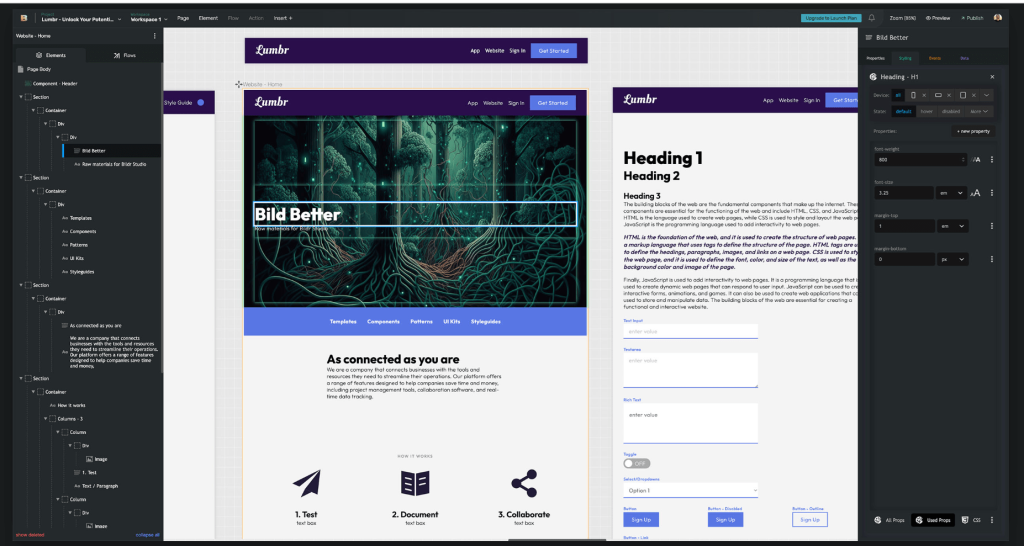
Bildr is another no code app builder where you can create your own applications using point-and-click functions, But wait, there is more to Bildr. Unlike other pure no-code app builders, this one lets you integrate your own JavaScript, CSS, and API calls.
This makes it quite unique in the sense that it’s perfect for hyper-personalization. You can build a wide range of Progressive Web Apps, web applications, and more. In fact, you can also create internal business tools like CRMS, dashboards, and workflow automation tools with this no code app builder.
The best way to get started is by using an external database like Airtable, Xano, or Supabase. But if you are into coding a little bit or want something of your own, you can build your database from scratch within Bildr itself.
If you are looking for data-driven apps, Bildr is an amazing place to get started. Reason? Well, this no code app builder allows you to bind real-time API data to other UI components.
With Bildr, you get the freedom to create your own layout. Bildr also features a powerful ui builder, allowing you to visually design app interfaces without coding and connect your front-end design with backend services.
While this might need a little bit of coding, it offers you extensive design freedom. So, if you want a fully customized layout, Bildr is your go-to option.
The only problem? You cannot publish your apps directly on Apple App Store or Google Play Store. Instead, this no code app builder apps work as web applications.
Features I Loved in Bildr
- Drag-and-drop editor with a blank canvas for full design control.
- Backend flexibility with database integrations and custom API calls.
- Workflow automation with triggers, conditions, and actions.
- Advanced security options with authentication integrations like Auth0.
- Stripe integration for payment processing.
- Real-time collaboration for team-based app development.
- Pre made functionality available through Bubble’s plugin marketplace, enabling rapid app development with ready-made components.
- Custom scripting support (JavaScript & CSS) for deeper customization.
- Responsive design for mobile and desktop apps.
Pricing
- Explore Plan: Free, limited access to features, ideal for testing the platform.
- Starter Plan: $29/month, allows for one published app with basic automation features.
- Pro Plan: $119/month, includes workflow automation, custom domains, and API integrations.
- Scale Up Plan: $500/month, offers up to 250,000 database records, team collaboration, and priority support.
9. Bravo Studio
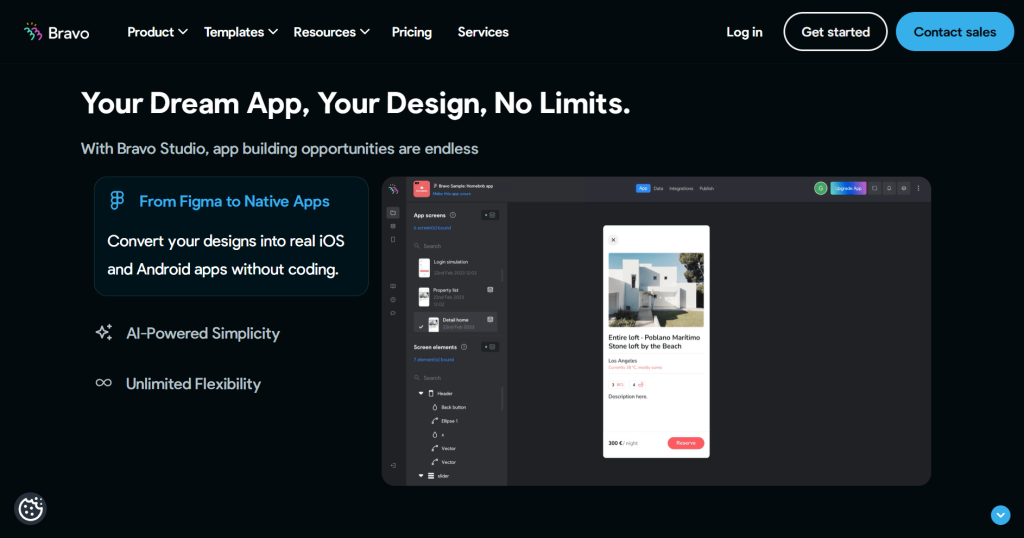
Do you use Figma for designing? Bravo could be an excellent no code app builder option for you. Forget fixed and rigid template designs.
This no code app builder allows you to turn pixel-perfect Figma designs into fully functional native mobile apps. Bravo is the only no code tool that enables you to directly convert Figma designs into real, native mobile apps without coding. You can build apps for the Apple App Store or Android Play Store.
This no code app builder is super flexible and can integrate with any API-based backends. So, it could be an excellent pick for developers who already have backend infra but are on the hunt for the right frontend solution.
This no code app builder does not offer built-in-backends. So, you’ll need to connect external backends like Xano or Firebase for logic and data storage.
That’s one thing that I did not like about this no-code app builder. You’ll need some ideas about AP integration. If you don’t, you might need to learn about that a bit.
When it comes to API integrations, you’ve got plenty of options with this no code app builder. Bravo supports Stripe for payments, Firebase for authentication, and features like QR scanning and real-time chat.
In short, Bravo Studio is ideal for business-to-consumer (B2C) apps, e-commerce platforms, and projects where branding and aesthetics are a top priority. But if you are looking for a no code app builder for an internal business application, you should avoid this one.
Moreover, the platform also lacks web app support. So, this no code app builder’s use is limited to mobile-only applications.
Features I Loved in Bravo Studio
- Figma & Adobe XD Integration – Converts Figma designs into fully functional native apps.
- Native Mobile App – Build and publish native mobile app experiences for iOS and Android, ready for submission to app stores.
- Bravo Tags – Add functionality to designs without coding.
- Bravo Vision – Share app prototypes without publishing them to app stores.
- API & Backend Support – Connects to Xano, Firebase, and other backend solutions.
- Stripe Integration – Built-in payment processing for e-commerce apps.
- Real-Time Chat & Video Call Support – Essential for communication apps.
- Version Control – Allows rollback to previous versions.
- Priority Support – Available on higher-tier plans.
Pricing
- Free: Build an app with up to 15 screens and share it with 3 people using Bravo Vision.
- Starter: $22/month, publish to app stores, 30 screens, unlimited sharing.
- Pro: $55/month, includes priority email support, retains Bravo branding.
- Advanced: $99/month, removes Bravo branding, adds QR & NFC tag support.
- Business: $222/month, includes 100 app screens, real-time chat, analytics, and onboarding support.
10. AppGyver
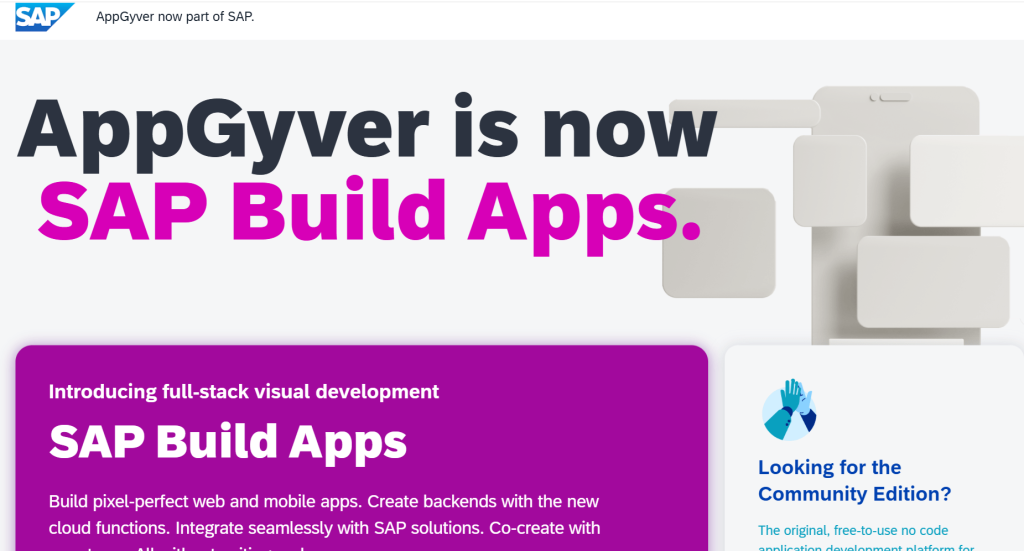
AppGyver is a no-code platform that allows users to create native mobile apps and web apps using an intuitive drag-and-drop interface. Acquired by SAP in 2021, AppGyver has become part of the SAP ecosystem, making it more relevant for businesses already using SAP tools.
However, as a standalone platform, AppGyver’s development has stagnated, with limited updates and declining support.
The platform enables users to build apps from scratch, offering a powerful visual editor that allows for pixel-perfect design control. AppGyver features a visual programming language, letting users build app logic and workflows without writing any code.
Unlike many other no-code builders, AppGyver does not provide templates, meaning users must manually construct every element. The learning curve is moderate, but quick tutorial videos help users get up to speed.
AppGyver is best suited for creating internal business applications, such as workflow automation tools, CRM boards, and simple websites. While it supports REST API connections, its lack of third-party integrations like Zapier, Google Sheets, and other common no-code tools limits its flexibility.
Additionally, the platform lacks an autosave feature, requiring users to manually save progress to avoid losing work.
Features I Loved in AppGyver
- Drag-and-drop builder – Highly customizable app-building experience.
- Intuitive building process – Step-by-step, visual construction of apps for flexible and modular development.
- Multi-device preview – Test app designs across mobile and tablet screens.
- REST API support – Connect with various backends for data transfer.
- SAP ecosystem integration – Ideal for businesses using SAP software.
- Logic canvas – Visually create workflows and app interactions.
- Full control over UI design – No restrictive templates, complete design freedom.
Pricing
- Community Edition: Free, allows app development with an Excel-based database.
- Enterprise Edition (SAP Build Apps): Costs $13,116 and includes advanced SAP ecosystem integration.
11. Thunkable

Thunkable is a no-code platform that’s specially designed for building native mobile apps. It offers developers a simple drag-and-drop feature. Hence, you need zero coding knowledge to craft an app. What’s innovative here is that you don’t get readymade templates.
Instead, you’ll have to start from scratch on a canvas. While this might need some more effort, you get extensive freedom in terms of design. So, if you are looking for complete control over your app’s interface and design, this no-code builder is a great option.
The platform consists of two main components: the Design tab and the Blocks tab. In the Design tab, users can build the app’s front end by dragging and customizing elements. Similarly, on the Blocks tab, designers can work on logic builders for backend workflow.
Users can integrate their apps with external databases like Google Sheets, Airtable, Firebase, Webflow, and Backendless, making it flexible for various use cases.
Thunkable is best suited for users who prioritize customization over ease of setup. The lack of a template library may be a drawback for beginners. However, building more advanced apps or integrating APIs may require some basic technical skills.
But what makes it better is its structured UI and strong community support, which help bridge the learning curve.
While it allows users to publish to the Apple App Store and Google Play Store, its pricing model limits downloads at lower tiers.
Features I loved in Thunkable
- Drag-and-drop builder – Full design control without coding.
- Database integration – Connects with Google Sheets, Airtable, Firebase, and more.
- Logic builder – Block-based backend creation for app functionality.
- Bluetooth integration – Enables apps to interact with external devices.
- Voice apps and voice based apps – Build voice assistants, chatbots, and other voice-driven experiences for web and mobile.
- Community support – Active forums and tutorials for troubleshooting.
- Cross-platform publishing – Publish apps to iOS, Android, and the web.
- Public Gallery – Explore and share apps within the Thunkable community.
Pricing
- Free: $0/month. This includes up to 3 public projects with a maximum of 5 screens per project.
- Builder: $59/month. This plan includes custom branding, 50 public projects, 10 private projects, 1 live published iOS and Android app, and chat support.
- Advanced: $189/month. This plan offers custom branding, unlimited public and private projects, unlimited published iOS and Android apps, in-app payments and ads, collaboration features, and priority support.
Wrapping Up
No code app builders have totally turned the tables for the application development process. Today, someone with zero knowledge can create hyper-fast and high-performing applications using these no code app builders, all without having to write code.
I hope this guide will help you pick the right one for you. To be honest, there are a lot more of such no code app builders in the market. But I picked the ones based on their performance and affordability. That’s why each one in the above list has a free plan.
You can test each tool without paying money. So don’t wait, get ready to make your move. I hope you find this list helpful. If you liked this one, make sure you explore our blog. You will find a lot more useful pieces there.
Till then, enjoy no-code app building!
FAQs
What’s the difference between no code app builders and low-code app builders?
The difference is simple. No code app builders do not need any sort of code for creating apps. But if you are using low code app builders, you will have to do some basic coding. In contrast, code apps are built entirely with traditional programming, requiring users to write all the code themselves.
Which no code app builder offers a free trial?
A lot of no code app builders mentioned in the above list offer free trials. You can check them out.
Are no code app builders really reliable and effective?
Yes, very much. These no code app builders are very powerful and AI-powered. So you can use them without any fuss. No code apps have become reliable and effective solutions for a wide range of use cases, making it easier than ever to build and scale applications without traditional coding.
